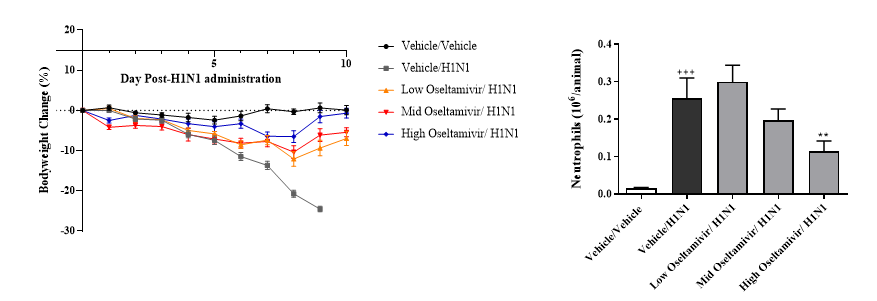Flu Model: H1N1 influenza lung infection model – viral COPD exacerbation
Influenza virus infection in humans results in a respiratory disease that ranges in severity from sub-clinical infection to primary viral pneumonia. 40-60% of acute exacerbations in COPD are associated with respiratory virus infection; 85% of asthma attacks in children and 44% in adults are precipitated by upper respiratory tract infection.
For the assessment of anti-virals there is an on-site microbiology Department who will prepare, assess the viral dose and can assess viral load in the lung tissue.
This model is also useful for assessing anti-inflammatories targeted at viral respiratory induced inflammation. We also have experience of using a steroid as a positive control.
The severity and length of the model can easily be manipulated by adjustment of the initial viral titre.

| Study Design | |
|---|---|
| Species/Strain | Balb/c or C57BL/6J mouse, ferret |
| Model | H1N1 influenza lung infection model |
| Relevant Use | Screening and assessment of new anti-viral and anti-inflammatory drugs for viral respiratory disease |
| Readouts Available | Daily Bodyweights and Clinical Signs, Lung Function (penH, Resistance, Compliance, FEV) Viral load, BAL differential cell counts, BAL cytokines and Pathology |
Study data generated by Labcorp Huntingdon Pharmacology.
Related Models
-
Bhas 42 Cell Transformation Assay (CTA)
Carcinogenicity, Discovery, Toxicology -
Asthma: Ovalbumin sensitization and challenge
Discovery -
Chlorine Induced Lung Injury
Discovery -
COPD: LPS + fMLP PK/PD model – Neutrophil Elastase Targets
Discovery -
COPD: Human Neutrophil Elastase Lung Hemorrhage Model
Discovery -
Bronchoconstriction models for LABA, LAMA & MABAs
Discovery -
Flu Model: H1N1 influenza lung infection model – viral COPD exacerbation
Discovery -
Model of Allergic Bronchopulmonary Aspergillosis (ABPA) in Mice
Discovery
